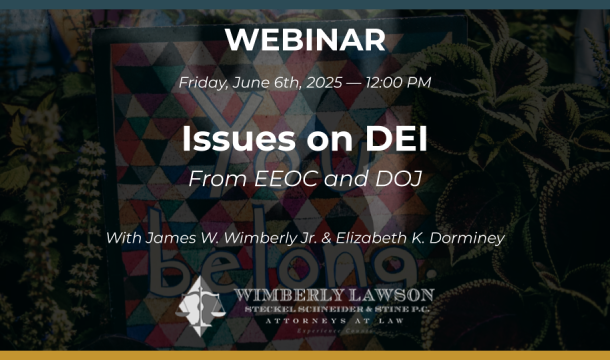ICE Issues Guidance for Employers Conducting Internal I-9 Audits
Most employers conduct internal I-9 audits although they are not technically required by law. On December 14, 2015, the U.S. Immigration Customs Enforcement (ICE) and Office of Special Counsel (OSC) issued guidance for employers conducting such audits.
The guidelines suggest that an employer may choose to review all forms I-9 or a sample collected based on neutral and non-discriminatory criteria. Employers should consider the process it will have for fielding questions or concerns about the audit and how it will inform the employees of that process. The guidance suggests informing the employees in writing that the employer will conduct an internal audit of forms I-9, explaining the scope and reason for the internal audit, stating whether the internal audit is independent of or in response to a government directive. When a deficiency is discovered in an employee’s Form I-9, the employer should notify the affected employee, in private, of the specific deficiency. The employer should provide the employee with copies of his or her Form I-9, any accompanying Form I-9 documents, and any other documentation showing the alleged deficiency.
Procedure for Correcting Errors or Omissions Found on Form I-9
1. What is the procedure for correcting errors or omission found on a Form I-9?
An employer may not correct errors or omissions in Section 1. If an employer discovers an error or omission in Section 1 of an employee’s Form I-9, the employer should ask the employee to correct the error. The best way to correct the error is to have the employee:
- Draw a line through the incorrect information;
- Enter the correct or omitted information; and
- Initial and date the corrections or omitted information.
Employees needing assistance to correct or enter omitted information in Section 1 can have a preparer and/or translator help with the correction or omitted information. The preparer or translator should:
- Make the correction or note the omitted information or help the employee make the correction or note the omitted information. The employee or preparer or translator should draw a line through the incorrect information and enter the correct information or note the omitted information;
- Have the employee initial and date the correction or omitted information if able; and
- Initial and date the correction or omitted information next to the employee’s initials.
If the preparer and/or translator who helped with a correction or noted omitted information completed the preparer and/or translator certification block when the employee initially completed the Form I-9, he or she should not complete the certification block again. If the preparer and/or translator did not previously complete the preparer and/or translator certification block, he or she should:
- Complete the certification block or;
- If the certification block was previously completed by a different preparer and/or translator;
- Draw a line through the previous preparer and/or translator information; and
- Enter the new preparer and/or translator information (and indicate "for corrections").
If the employee is no longer working for the employer, the employer should attach to the existing form a signed and dated statement identifying the error or omission and explaining why corrections could not be made (e.g., because the employee no longer works for the employer).
An employer may only correct errors made in Section 2 or Section 3 of the Form I-9. The best way to correct the form is to:
- Draw a line through the incorrect information;
- Enter the correct or omitted information; and
- Initial and date the correction or omitted information.
An employer should not conceal any changes made on the Form I-9 - for example, by erasing text or using correction fluid, nor should the employer backdate the Form I-9.
An employer that made multiple errors in Section 2 or 3 of the form may redo the section(s) containing the errors on a new Form I-9, and attached it to the previously completed form. An employer should attach an explanation of the changes made to an existing Form I-9 or the reason a new Form I-9 was completed, and sign and date the explanation.
2. What should an employer do when it discovers during an internal audit that (1) a Form I-9 for an employee was not completed or missing, or (2) an entire section on the Form I-9 was left blank?
If a Form I-9 was never completed or is missing, the current version of the Form I-9 should be completed as soon as possible. If an original Form I-9 exists but either Section 1 or Section 2 was never completed, the employee (for Section1) or the employer (for Section 2) should complete the section as soon as possible. In both scenarios, the employer should not backdate the form, but should clearly state the actual date employment began in the certification portion of Section 2. The employer should attach a signed and dated explanation of the corrective action taken.
3. May an employer complete new Forms I-9 for existing employees whose Forms I-9 do not contain sufficient documentation to meet employment eligibility verification requirements?
Yes. When a Form I-9 does not reflect that the employee provided sufficient documentation upon hire or reverification under Form I-9 rules current at the time of hire or reverification, an employer should ask the employee to present documentation sufficient to meet the requirements of the current version of the Form I-9. The employer should staple the completed and signed Section 2 or 3 of the current version of the Form I-9 to the employee’s previous Form I-9, together with a signed and dated explanation of the corrective action taken. The employer should not backdate the Form I-9. An employer must give an employee the option to present acceptable documentation of the employee’s choice to bring the Form I-9 into compliance with the INA.
4. What should an employer do if an internal audit uncovers photocopies of Form I-9 documents that do not appear to be genuine or to relate to the individual who presented them?
The standard for reviewing Form I-9 documentation during an internal audit does not change from the standard applied during the initial employment eligibility verification process. An employer is required to accept original Form I-9 documentation that reasonably appears to be genuine and to relate to the individual presenting the documentation. If an employer subsequently concludes that a document does not appear to be genuine or to relate to the person who presented it, the employer should address its concerns with the employee and provide the employee with the opportunity to choose a different document to present from the Lists of Acceptable Documents. An employer may not conclude without foundation that a photocopy of an employee’s Form I-9 documentation is not genuine or does not relate to the individual. In the context of an internal audit, for an employer that has photocopied Form I-9 documentation, it should recognize that it may not be able to definitively determine the genuineness of Form I-9 documentation based on photocopies of the documentation. An employer should not request documentation from an employee solely because photocopies of documents are unclear.
5. May an employer request specific documents when correcting as Form I-9 as a result of an internal audit?
No. While an employer may specify that the particular document called into question by the internal audit may not be used again for Form I-9 purposes, the employer should not request specific documents. The employee should be permitted to present his or her choice of other documents, as long as they are acceptable for employment eligibility verification purposes.
6. May an employer require its existing employees to complete new Forms I-9 instead of conducting an internal audit because many existing Forms I-9 appear to be deficient?
An employer is cautioned against obtaining new Forms I-9 from its existing employees (absent acquisition or merger) without regard to whether a particular Form I-9 is deficient or without reason to believe that systematic deficiencies in the employer’s employment eligibility verification process call the integrity of all previously completed Forms I-9 into question. Without sufficient justification, requiring an existing employee to complete a new Form I-9 may raise discrimination concerns.
7. Must an employer always provide employees with at least 90 days to provide Form I-9 documentation where alternative documentation is required?
No. The employer sanctions provision of the INA makes it unlawful for a person or other entity, after hiring an alien for employment, to continue to employ the alien knowing that the alien is, or has become, unauthorized for employment. The employer should provide all employees who claim they are work-authorized with a reasonable amount of time to address any deficiencies associated with their Forms I-9 and should not summarily discharge employees without providing a process for resolving the discrepancy. The 90-day period set forth in U.S. Department of Homeland Security Safe-Harbor Procedures for Employers Who Receive a No-Match Letter, 72 Fed. Reg. 45611 (Aug. 15, 2007) was rescinded, so the 90-days is not a legally binding regulatory requirement. An employer should recognize that some documents may take up to or more than 120 days to obtain. The reasonableness of a timeframe should be determined on a case-by-case basis. Factors to consider include, for example, the specific nature of the deficiency and the time required for alternative Form I-9 documentation to be obtained under the circumstances.
8. Immigration and Customs Enforcement (ICE) presumes that an employer has acted reasonably if it takes appropriate actions to resolve the apparent employment of unauthorized employees within 10 days of receiving a Notice of Suspect Documents letter. In the context of an internal audit, should an employer also provide employees only 10 days to present acceptable alternative documentation?
No. The 10-day period is an ICE policy that applies solely when ICE has issued a Notice of Suspect Documents letter. In these cases, ICE has already determined the employee at issue does not appear to be presently work-authorized. This time period has no bearing on the amount of time an employer may provide its employees to address discrepancies discovered through an internal audit.
9. What should an employer do if the employee is unable to present acceptable documents within what the employer has determined to be a reasonable amount of time?
An employer should consider the reasons for an employee’s inability to present acceptable documentation and determine whether an extended period of time would be appropriate based on the particular circumstances on a case-by-case basis. An employer should be sure to allow or disallow additional time based on objective non-discriminatory and non-retaliatory criteria and without regard to an individual employee’s citizenship status or national origin. The employer should document the basis for its decision and continue to document the efforts of the employee to obtain acceptable Form I-9 documentation.
10. Is an employer required to terminate employees who, as a result of the employer’s internal Form I-9 audit, disclose that they were previously not employment-authorized, even though they are currently employment-authorized?
No. This is not required by law. In cases where an employee has worked without employment authorization or with a false identity or fraudulent employment document(s), and the employee has subsequently presented acceptable documentation(s) and is currently employment-authorized, the employment eligibility verification provisions do not require termination of employment. An employer may continue to employ the employee upon completion of a new Form I-9 noting the authorizing document(s), and should attach the new Form I-9 to the previously completed From I-9 together with a signed and dated explanation.
11. May an employer audit a particular employee’s Form I-9 in response to a tip that the employee is not work-authorized?
An employer violates the employer sanctions provision of the INA if it continues to employ an employee with actual or constructive knowledge that the employee is unauthorized to work. While tips concerning an employee’s immigration status may lead to the discovery of an unauthorized employee, tips and leads should not always be presumed to be credible. An employer is cautioned against responding to tips that have no indicia of reliability, such as unsubstantiated, retaliatory, or anonymous tips. Heightened scrutiny of a particular employee’s Form I-9 or the request for additional documentation from the employee based on unreliable tips may be unlawful, particularly if the tip was made based upon retaliation, the employee’s national origin or perceived citizenship status.
12. Should an employer use the Social Security Number Verification Service (SSNVS) during an internal audit?
No. According to the SSNVS Handbook, "SSA will verify [Social Security numbers] and names solely to ensure that the records of current or former employees are correct for the purpose of completing Internal Revenue Service (IRS) Form W-2 (Wage and Tax Statement)." Handbook, p. 4. Additionally, the SSNVS handbook states that any notification about a mismatch makes no statement about an employee’s immigration status. Rather, it simply indicates an error in either the employer’s records or SSA’s records and should not be used as a basis to take adverse actions against an employee.
Related Content
Get Email Updates

The EEOC and DOJ Issue Guidance on DEI

Considerations When Government Officials Show Up and Request to Meet with Individual Employees

How Jurors Evaluate the Fairness of an Employer’s Actions

Some of the Controversial Issues Currently Being Faced by Employers in Light of Recent Developments

Frequently Asked Questions About Recent Immigration-Related Actions


